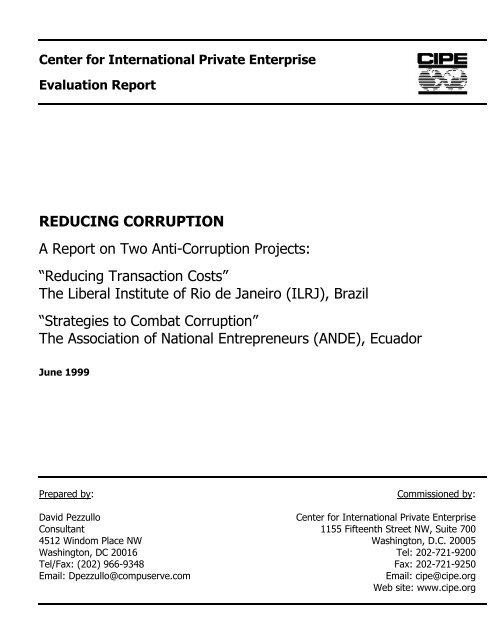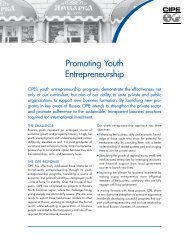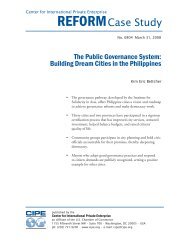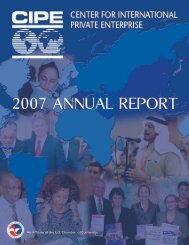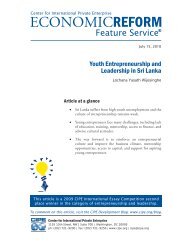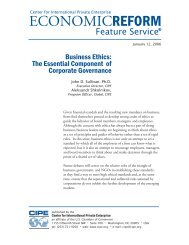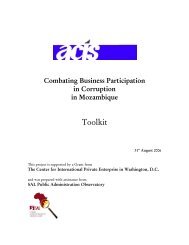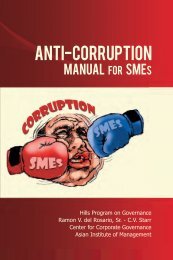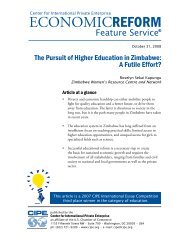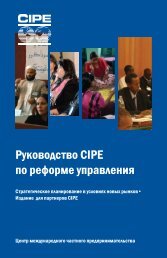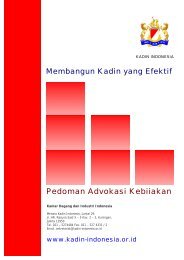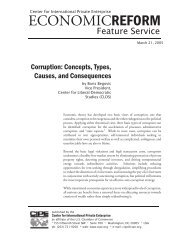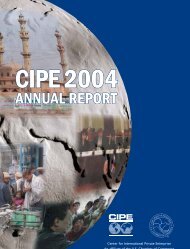REDUCING CORRUPTION A Report on Two Anti-Corruption Projects
REDUCING CORRUPTION A Report on Two Anti-Corruption Projects
REDUCING CORRUPTION A Report on Two Anti-Corruption Projects
Create successful ePaper yourself
Turn your PDF publications into a flip-book with our unique Google optimized e-Paper software.
Center for Internati<strong>on</strong>al Private EnterpriseEvaluati<strong>on</strong> <str<strong>on</strong>g>Report</str<strong>on</strong>g><str<strong>on</strong>g>REDUCING</str<strong>on</strong>g> <str<strong>on</strong>g>CORRUPTION</str<strong>on</strong>g>A <str<strong>on</strong>g>Report</str<strong>on</strong>g> <strong>on</strong> <strong>Two</strong> <strong>Anti</strong>-Corrupti<strong>on</strong> <strong>Projects</strong>:“Reducing Transacti<strong>on</strong> Costs”The Liberal Institute of Rio de Janeiro (ILRJ), Brazil“Strategies to Combat Corrupti<strong>on</strong>”The Associati<strong>on</strong> of Nati<strong>on</strong>al Entrepreneurs (ANDE), EcuadorJune 1999Prepared by:Commissi<strong>on</strong>ed by:David PezzulloCenter for Internati<strong>on</strong>al Private EnterpriseC<strong>on</strong>sultant 1155 Fifteenth Street NW, Suite 7004512 Windom Place NW Washingt<strong>on</strong>, D.C. 20005Washingt<strong>on</strong>, DC 20016 Tel: 202-721-9200Tel/Fax: (202) 966-9348 Fax: 202-721-9250Email: Dpezzullo@compuserve.comEmail: cipe@cipe.orgWeb site: www.cipe.org
EXECUTIVE SUMMARYThe two projects addressed in this evaluati<strong>on</strong> focused <strong>on</strong> changing specific procedures, as well aspromoting strategies to curb corrupti<strong>on</strong>. Both projects completed all proposed activities competently,with the excepti<strong>on</strong> of the Liberal Institute’s diagnosis of deregulati<strong>on</strong>. Furthermore, these projectsachieved most of their broader impact goals.In Brazil, the Liberal Institute of Rio de Janeiro (ILRJ) has for over a decade produced in-depthdiagnostic studies <strong>on</strong> key public policy issues. These studies recommend specific measures to reducecosts while enhancing competiti<strong>on</strong> and ec<strong>on</strong>omic efficiency. The study recommendati<strong>on</strong>s are oftenpromoted in seminars to enhance awareness am<strong>on</strong>g key stakeholders, as well as the public at large. Forthis project that highlighted reducing transacti<strong>on</strong> costs, the ILRJ was to focus its studies and awarenessraising<strong>on</strong> three key areas: labor courts, procurement and deregulati<strong>on</strong>.ILRJ produced two in-depth diagnostic studies <strong>on</strong> labor courts and government procurement. A thirdstudy <strong>on</strong> deregulati<strong>on</strong> was never thoroughly completed. The two completed studies, as well as the outlineof the never completed deregulati<strong>on</strong> study were used to orient two c<strong>on</strong>ferences in Brasilia (September1996) attended by key c<strong>on</strong>gressi<strong>on</strong>al stakeholders and the press.A summary of ILRJ project impact includes:♦ <strong>Two</strong> of the four labor court study recommendati<strong>on</strong>s regarding abolishing “classista” representativesand facilitating pre-trail negotiati<strong>on</strong> have been adopted♦ More than half of the eleven procurement study recommendati<strong>on</strong>s have been adopted and otherrecommendati<strong>on</strong>s are being c<strong>on</strong>sidered for adopti<strong>on</strong>♦ While a thorough deregulati<strong>on</strong> study was not completed, a preliminary study raised awareness <strong>on</strong> thedangers of a regulati<strong>on</strong> regime increasing transacti<strong>on</strong> costsILRJ, working with its sister chapter in Brasilia and collaborating with the Nati<strong>on</strong>al C<strong>on</strong>federati<strong>on</strong> ofIndustry, was successful in effecting changes of law and procedures in as much as it focused <strong>on</strong> discreetareas of reform where it was in a positi<strong>on</strong> to utilize diagnostic studies to catalyze a str<strong>on</strong>g c<strong>on</strong>stituency ofinterest to reduce transacti<strong>on</strong> costs.ILRJ’s strength lies in the credibility of its diagnostic studies that have earned a solid reputati<strong>on</strong> byemploying credible data to examine the correlati<strong>on</strong> between costs and benefits of given policies. On theother hand, ILRJ is not organizati<strong>on</strong>ally well positi<strong>on</strong>ed to facilitate a broader debate with aheterogeneous c<strong>on</strong>stituency regarding <strong>on</strong>going, sec<strong>on</strong>d generati<strong>on</strong> reform in key areas such asderegulati<strong>on</strong>, taxati<strong>on</strong>, and rule of law.Looking to the future, ILRJ's potential for effecting reform will rest <strong>on</strong> the same careful focus <strong>on</strong>discreet or ripe reform issues. It is struggling to reorganize, build alliances and refocus to play a largerrole. If it is successful, its impact <strong>on</strong> the <strong>on</strong>going debate <strong>on</strong> tax and judicial reform could be significant.Furthermore, if ILRJ manages greater organizati<strong>on</strong>al coherence in its various (eight) regi<strong>on</strong>al chapters, itcould play a decisive role in helping advocate and design competent municipal and regi<strong>on</strong>al financialmanagement systems. Regi<strong>on</strong>al and local governments manage a full third of the government budget yetfor the most part, these entities are utilizing makeshift and opaque financial systems which enableinefficiency and misuse of public funds. Apparently these systems are ripe for change and evidence in theregi<strong>on</strong> to date suggests that the state and local c<strong>on</strong>text is generally more resp<strong>on</strong>sive to pressures forchange and more amenable to well organized reform advocacy programs.
Evaluati<strong>on</strong> <str<strong>on</strong>g>Report</str<strong>on</strong>g>Reducing Corrupti<strong>on</strong>term reform measures and develop a broader c<strong>on</strong>stituency to sustain reform at <strong>on</strong>e and the same time.Key factors in sustaining reform are technical proficiency and broad-based support. This implies thatCIPE projects should:♦ work to effect immediate change in laws and procedures as opportunities emerge;♦ reach out to varied stakeholders to enhance trust and build social capital, develop c<strong>on</strong>sensus am<strong>on</strong>g abroad c<strong>on</strong>stituency for an <strong>on</strong>going reform effort; and♦ engage large d<strong>on</strong>ors to ensure that nati<strong>on</strong>al reform and anti-corrupti<strong>on</strong> efforts are c<strong>on</strong>textualized andenjoy broad ownership.
Evaluati<strong>on</strong> <str<strong>on</strong>g>Report</str<strong>on</strong>g>Reducing Corrupti<strong>on</strong>INTRODUCTIONThis <str<strong>on</strong>g>Report</str<strong>on</strong>g> will cover:1) The success or lack of success with which the activities required of each project were completed;2) The impact these activities had up<strong>on</strong> level of debate, promoting strategies to combat corrupti<strong>on</strong>,changes in laws and policy as well as and other broader project and CIPE objectives;3) The nati<strong>on</strong>al and organizati<strong>on</strong>al c<strong>on</strong>text in which these activities were accomplished;4) The validity of presuppositi<strong>on</strong>s related to both c<strong>on</strong>textual factors – political will, public interest inissue, commitment and leverage of key stakeholder groups, instituti<strong>on</strong>al capacity to digest andimplement reform – and project methodology;5) Recommended next steps for grantee organizati<strong>on</strong>s and CIPE that flow from these two projects;Finally, the evaluati<strong>on</strong> will include:6) A brief comparis<strong>on</strong>s of the two projects; and7) Comments <strong>on</strong> what these projects suggest about a possible CIPE anti-corrupti<strong>on</strong> strategy for theregi<strong>on</strong>.METHODOLOGYIn order to: 1) explicitly evaluate the various comp<strong>on</strong>ents of each project; 2) assess levels ofachieving broader objectives and; 3) identify anti-corrupti<strong>on</strong> opportunities suggested by the two projects,the evaluati<strong>on</strong> utilized a number of sources of informati<strong>on</strong>.1) Background Interviews: with d<strong>on</strong>or representatives, advocacy and academic organizati<strong>on</strong>s, as well asregi<strong>on</strong>al governance and development experts.2) Structured Interviews with Grantee Staff and Key Stakeholders: in Rio de Janeiro (May 24 - 26,1999); Brasilia (May 26 - 30, 1999) and; Quito (May 31–June 4, 1999) with key pers<strong>on</strong>nel at both theLiberal Institute and ANDE, and with select in-country stakeholders and experts from the privatesector, the NGO community, the press, d<strong>on</strong>or community, c<strong>on</strong>sumer, youth, religious andprofessi<strong>on</strong>al organizati<strong>on</strong>s as well as relevant state entities. (see Annex A for a list of in-countrypers<strong>on</strong>s interviewed)3) File and Literature Review: including project documents, missi<strong>on</strong> statements, final reports, diagnosticstudies, commentary <strong>on</strong> forums and other project events, promoti<strong>on</strong>al documents, press reports,speeches, government documentati<strong>on</strong> <strong>on</strong> changes in procedures, legislati<strong>on</strong>, policy and strategy(including acti<strong>on</strong> plans), documentati<strong>on</strong> regarding c<strong>on</strong>sensus building and participatory acti<strong>on</strong>planning experiences and methodologies employed by key d<strong>on</strong>or, academic and grant makingorganizati<strong>on</strong>s, as well as, studies assessing ec<strong>on</strong>omic and instituti<strong>on</strong>al reform efforts in the regi<strong>on</strong>.1
Evaluati<strong>on</strong> <str<strong>on</strong>g>Report</str<strong>on</strong>g>Reducing Corrupti<strong>on</strong>I. BRAZILBackgroundIn late 1970’s early 1980s hyperinflati<strong>on</strong> began undermining the Brazilian ec<strong>on</strong>omy whose macroec<strong>on</strong>omicperformance had been impressive since the 1950’s. Driven to a great extent by excessive statespending <strong>on</strong> government programs, bureaucracy and state enterprises, inflati<strong>on</strong> was addressed fr<strong>on</strong>tally bythe government of President Cardoso beginning in 1993 with “Plan Real”. Privatizati<strong>on</strong> of a number ofkey state enterprises has helped cut spending and significantly reduce the size of the foreign debt. This,as well as enhanced fiscal discipline, has generated a sharp reducti<strong>on</strong> in inflati<strong>on</strong>.Late 1998 shocks sparked by the financial market collapse in Russia have led to sharp outflows ofinvestment in Brazil deflating the currency and feeding a recessi<strong>on</strong>ary trend that included highunemployment. The ec<strong>on</strong>omy over the last few m<strong>on</strong>ths has recovered more quickly than many expectedand the state has managed the immediate fiscal crunch. But clearly more hardship is in the forecast. Mostpolls rate unemployment the primary public c<strong>on</strong>cern.Observers agree that there is very little likelihood of any slippage back to renewed levels of stateownership, spending and interventi<strong>on</strong>. But there remains some questi<strong>on</strong> whether <strong>on</strong>going sec<strong>on</strong>dgenerati<strong>on</strong> ec<strong>on</strong>omic and instituti<strong>on</strong>al reform will be energetically embraced to modernize the state thatstill is large and costly. While the first stage of reforms have helped Brazil overcome hyperinflati<strong>on</strong>, thenati<strong>on</strong>’s competitive standing still remains weak even as compared with neighbors.After re-electi<strong>on</strong> late last year then devaluati<strong>on</strong> of the currency, President Cardoso has been beset bypolitical troubles. His popularity ratings are at record lows, his cabinet is in some disarray and key taxreforms measures are floundering as the four party coaliti<strong>on</strong> that supported him in C<strong>on</strong>gress has begun tosag. On the other hand a center-right majority in C<strong>on</strong>gress is for the first time experimenting with takingthe reform initiative. Special legislative commissi<strong>on</strong>s are preparing to present tax and judicial reformproposals sometime this year. It is uncertain whether the President will pay these initiatives any heed.Based <strong>on</strong> a loop-hole in the 1988 c<strong>on</strong>stituti<strong>on</strong>, the Executive has managed to mostly manhandle C<strong>on</strong>gress(even <strong>on</strong>e that has for the most part supported his reform agenda) by utilizing provisi<strong>on</strong>al executivemeasures that are renewable m<strong>on</strong>thly without c<strong>on</strong>gressi<strong>on</strong>al vote. This means that the central questi<strong>on</strong> inBrazil is whether further instituti<strong>on</strong>al reform is <strong>on</strong> the President’s agenda for this year. By spring nextyear the campaigning for late 2000 municipal electi<strong>on</strong>s will supercede reform c<strong>on</strong>siderati<strong>on</strong>s.The President could let the reform process drift leaving the Brazilian state in limbo betweenmodern/global and costly/interventi<strong>on</strong>ist. The fundamental instituti<strong>on</strong>al framework for steady growth,str<strong>on</strong>g and sustainable investment, low unemployment and decent services is not yet in place.The c<strong>on</strong>stituency that has pressed for reform is also less than vigorous and uniform. Even the mostavid advocates of reform have benefited richly from state subsidies, protecti<strong>on</strong> and interventi<strong>on</strong>s over theyears. The electoral system set up during the military years weighs heavily toward the more feudal norththat for the time being is pro- liberalizati<strong>on</strong> but not squarely pro-modernizati<strong>on</strong>. This all suggests thatmost Brazilian stakeholders who have supported privatizati<strong>on</strong> and reform efforts have d<strong>on</strong>e so for shortand mid term returns to overcome the inflati<strong>on</strong> crisis. The support for l<strong>on</strong>g term, integrated reform is noteasy to come by. This mirrors a regi<strong>on</strong>al trend – reforms initiated during crisis have stalled when theworst of the crisis is overcome.Various private sector groups have coined the slogan “Custo Brasil” to mobilize <strong>on</strong>going support forliberalizati<strong>on</strong> to reduce transacti<strong>on</strong> costs that make Brazilian goods less competitive <strong>on</strong> the global market.This tact has proved effective in focusing reform and liberalizati<strong>on</strong> efforts <strong>on</strong> benefits to Brazil’s2
Evaluati<strong>on</strong> <str<strong>on</strong>g>Report</str<strong>on</strong>g>Reducing Corrupti<strong>on</strong>ec<strong>on</strong>omy. As of yet, however, this has been champi<strong>on</strong>ed by industry and has not been systematicallyrelated to employment and c<strong>on</strong>sumer prices where a potentially vast c<strong>on</strong>stituency for change remainsmostly untapped.Organizati<strong>on</strong>The Liberal Institute of Rio de Janeiro was founded 15 years ago by D<strong>on</strong>ald Steward as a vehicle totranslate, disseminate and study liberal writings and most particularly those by Fredrich Hayek. Over theyears, seven additi<strong>on</strong>al branches of the Institute were founded in other cities enjoying a total membershipof several thousand entrepreneurs. Six years ago, with CIPE support, the ILRJ began publishing am<strong>on</strong>thly series of diagnostic studies <strong>on</strong> key nati<strong>on</strong>al issues. These “Notas,” addressing everything fromc<strong>on</strong>stituti<strong>on</strong>al reform to fighting poverty, combine theory, empirical data, and cross country analysis toadvocate a series of measures to improve public service and ec<strong>on</strong>omic performance. These studies al<strong>on</strong>gwith research published in the Institute’s quarterly magazine “Think Tank” and more in-depth whitepapers have been systematically distributed to key stakeholders in and out of government. These writingand related seminars have been part of the liberalizing trend in Brazil offering liberal policy opti<strong>on</strong>s thatwere taboo a few decades ago. But much like the government reform process is having trouble goingfrom stage <strong>on</strong>e – urgent reforms – to stage two and more underlying instituti<strong>on</strong>al reengineering, ILRJ isfinding it difficult to go from effecting the debate as outsiders with whom some have been willing tofashi<strong>on</strong> a tactical alliance <strong>on</strong> given projects, to being part of a broad and deep strategic alliance forsubstantive and <strong>on</strong>going change.Membership for the key chapters – Rio and Sao Paolo – has shrunk since the apparent victories(including the CIPE financed studies and c<strong>on</strong>ferences) in effecting policy. Furthermore, despitefundraising efforts, many chapters have not been successful in attracting new sources of support.Evaluator’s NoteThe Liberal Institute’s diagnostic studies have earned a reputati<strong>on</strong> for professi<strong>on</strong>alism. A select andspecialized audience find them very effective in buttressing the case for reducing state interventi<strong>on</strong> toimprove public policy in a number of key areas. The Institute’s role as a facilitator of debate to helpdevelop a broader c<strong>on</strong>sensus for change is more suspect. The Liberal Institute has been part of atransformati<strong>on</strong> of outlook in Brazil, however it remains ideologically isolated. In given discreet cases itcan effect changes in law where a str<strong>on</strong>g specialized c<strong>on</strong>stituency already exists. In order to positi<strong>on</strong> itselfto have significant impact <strong>on</strong> the broader transacti<strong>on</strong> cost debate and design projects to effect instituti<strong>on</strong>alchange systematically ILRJ will have to go through some transformati<strong>on</strong> of identity and organizati<strong>on</strong>alreach. The leadership is aware of this crossroads.Project – Reducing Transacti<strong>on</strong> CostsThe Liberal Institute of Rio de Janeiro had experience before this CIPE project in:1- producing in-depth diagnostic studies <strong>on</strong> key policy issues;2- organizing c<strong>on</strong>ferences in an effort to press for implementati<strong>on</strong> of specific policy recommendati<strong>on</strong>s,and;3- lobbying with like-minded stakeholders for legal and policy changes.The CIPE-funded transacti<strong>on</strong> cost project focused <strong>on</strong> three key areas - government regulati<strong>on</strong>, laborcourts and government procurement – that were explicitly related to the C<strong>on</strong>federati<strong>on</strong> of Industries<strong>on</strong>going “Custo Brasil” effort. More significantly, this project explicitly linked diagnostic studies toc<strong>on</strong>ferences to build support for legislative changes and to lobby for passage of specific laws. This3
Evaluati<strong>on</strong> <str<strong>on</strong>g>Report</str<strong>on</strong>g>Reducing Corrupti<strong>on</strong>project, therefore, represented an extensi<strong>on</strong> of the Liberal Institute’s methodology to effect change bylinking comp<strong>on</strong>ents in an integrated fashi<strong>on</strong> folded into an alliance with a key stakeholder group (in thiscase the C<strong>on</strong>federati<strong>on</strong> of Industry).The broader objectives of the project were:• To develop data <strong>on</strong> the causes of high transacti<strong>on</strong> costs in Brazil, ec<strong>on</strong>omic impact and political andsocial c<strong>on</strong>sequences• To propose prescriptive recommendati<strong>on</strong>s for reducing such costs• To encourage government officials to implement the workshop recommendati<strong>on</strong>s through outreachactivities such as workshops with business and government leaders, media, and advocacyThe diagnostic studies were written according to the specificati<strong>on</strong>s laid out in the agreement withCIPE. The two studies <strong>on</strong> labor courts and procurement c<strong>on</strong>tained the detailed empirical data thatstr<strong>on</strong>gly supported specific policy recommendati<strong>on</strong>s and changes in law. The study <strong>on</strong> deregulati<strong>on</strong> wasnot successful in amassing the data that justified specific recommendati<strong>on</strong>s. According to the author, thenewness of the regulati<strong>on</strong> regime (following privatizati<strong>on</strong>) meant that little reliable data was available.The study, therefore, never produced a “Nota” with specific recommendati<strong>on</strong>s based <strong>on</strong> data.Procurement: Of the 11 specific recommendati<strong>on</strong>s offered by the diagnostic study or “Nota,” sevenhave been adopted by law or by decree. An eighth recommendati<strong>on</strong> has been indirectly adopted through abroad draft bill <strong>on</strong> fiscal resp<strong>on</strong>sibility. Those adopted include:1- better disseminati<strong>on</strong> of bidding rules (including creati<strong>on</strong> of a databank);2- minimizing discreti<strong>on</strong>ary power of the purchasing agent by enhancing transparency;3- clarifying definiti<strong>on</strong> of decisi<strong>on</strong> levels;4- enhancing competiti<strong>on</strong> am<strong>on</strong>g bidders;5- pre-qualifying bidders according to clear rules;6- broadening the criteria (bey<strong>on</strong>d <strong>on</strong>ly lowest price) for evaluating proposals;7- making provisi<strong>on</strong> for dismissal of bidding requirements in urgent cases.Labor Courts: Of the several major recommendati<strong>on</strong>s offered by the diagnostic study, two substantiverecommendati<strong>on</strong>s have been adopted and are presently reflected in new laws. Arbitrati<strong>on</strong> has beenadopted in commercial cases to reduce the caseload and length of cases. And in the middle of May(1999), a law abolishing the “classista” representatives was adopted. The first represents an importantprecedent for settling disputes and the sec<strong>on</strong>d overcame the interest of specialized labor lawyers whoperformed this representative functi<strong>on</strong> that served to sharpen disputes and thus increase the cost andlength of cases.The key to the success of the Labor Court and Procurement efforts had to do with a number offactors.1- The focus – the high cost and dubious utility of Labor Courts and the antiquated, inefficient andinfluence rift Procurement System – had for a l<strong>on</strong>g time been the focus of c<strong>on</strong>cern am<strong>on</strong>g many keystakeholders;2- The use of substantive, solid empirical data – in the case of Labor Courts <strong>on</strong> numbers and length ofcases, costs, over the years while in the case of Procurement cost of lack of transparency andcompetiti<strong>on</strong>;3- The several cycles of efforts to implement changes which suggested the most likely avenues foreffective acti<strong>on</strong>;4
Evaluati<strong>on</strong> <str<strong>on</strong>g>Report</str<strong>on</strong>g>Reducing Corrupti<strong>on</strong>4- The specificity of the recommendati<strong>on</strong> in the diagnostic study (justified by c<strong>on</strong>vincing empiricalstudy of cost and benefit) offers a clear list of next steps and methods of measuring progress in theirimplementati<strong>on</strong>;5- The success in facilitating – utilizing stakeholder c<strong>on</strong>ferences and discreet lobbying – thedevelopment of a specialized c<strong>on</strong>stituency for change;6- Finally, in the case of the Labor Court work there was good timing – a c<strong>on</strong>textual factor bey<strong>on</strong>d thereach of the CIPE – as press focus <strong>on</strong> corrupti<strong>on</strong> in the building of a labor court generated a publicdemand for change.Deregulati<strong>on</strong>: The elements in the deregulati<strong>on</strong> comp<strong>on</strong>ent were generically the same as the otherstudies. But as menti<strong>on</strong>ed above, little empirical data was available to buttress recommendati<strong>on</strong>s.Specific recommendati<strong>on</strong>s supported by data were not made or adopted. While falling well short of itsobjectives, the outline of a study presented at the September c<strong>on</strong>ferences were successful in raisingawareness regarding the dangers of an excessive deregulati<strong>on</strong> regime growing in the wake ofprivatizati<strong>on</strong>Outreach Activities<strong>Two</strong> <strong>on</strong>e day c<strong>on</strong>ferences in Brasilia were organized to present the recommendati<strong>on</strong>s, disseminate thestudies, illicit press coverage and build awareness particularly am<strong>on</strong>g key members of C<strong>on</strong>gress.- Over <strong>on</strong>e hundred key stakeholders attended the September 17, 1996 c<strong>on</strong>ference. The c<strong>on</strong>ferencewas organized into three panel discussi<strong>on</strong>s (<strong>on</strong>e each <strong>on</strong> Labor Courts, Procurement, andDeregulati<strong>on</strong>) that included presentati<strong>on</strong>s of the “Nota” findings and recommendati<strong>on</strong>s as well aspresentati<strong>on</strong>s by other experts <strong>on</strong> the issues.- The Sec<strong>on</strong>d c<strong>on</strong>ference <strong>on</strong> September 19, 1996 was organized in a similar fashi<strong>on</strong> yet attracted ac<strong>on</strong>siderably smaller audience.Pre-suppositi<strong>on</strong>sThe Liberal Institute of Rio had assumed that the weight of its intellectual arguments particularly asfocused <strong>on</strong> a group of mostly ideologically friendly members of the government and legislators in alliancewith the C<strong>on</strong>federati<strong>on</strong> of Industry – a natural and l<strong>on</strong>g standing ally – would be enough to effect changeto reduce transacti<strong>on</strong> costs. This project proved this presuppositi<strong>on</strong> largely correct. However,circumstances have changed somewhat. In the face ofthe Institute’s sagging membership and financial support, and flagging will of President Cardoso topress for <strong>on</strong>going reforms, these presuppositi<strong>on</strong>s are being re-examined in regard to future efforts.Evaluator’s CommentsThis project was highly successful. All objectives were met or exceeded particularly regarding laborcourts and procurement. In these two areas, data was developed, recommendati<strong>on</strong>s were proposed, astakeholder c<strong>on</strong>stituency was cultivated, officials were systematically lobbied and manyrecommendati<strong>on</strong>s were adopted. The relative failure of the deregulati<strong>on</strong> comp<strong>on</strong>ent in relati<strong>on</strong> to laborcourts and procurement suggests that the Liberal Institute’s approach was successful when very carefullyselected (ripe) reforms were targeted utilizing empirical data to justify very specific recommendati<strong>on</strong>s.The specificity of recommendati<strong>on</strong>s in areas l<strong>on</strong>g perceived as inefficient or corrupt made thedevelopment of outreach mechanisms to engage friendly audiences relatively easy.5
Evaluati<strong>on</strong> <str<strong>on</strong>g>Report</str<strong>on</strong>g>Reducing Corrupti<strong>on</strong>Looking to the future, other very specific and ripe targets could be identified and targeted for reform.At the same time a broader approach, engaging various potential c<strong>on</strong>stituencies may prove essential if awide ranging reform agenda is to succeed.Recent studies regi<strong>on</strong>-wide str<strong>on</strong>gly suggest that technocrats and private sector advocates of liberalreform remain to most of the populace and most of the press suspect as motors of positive change andguardians of nati<strong>on</strong>al policy. In times of acute crisis they have been deferred to. But as urgency (in thecase of Brazil, hyperinflati<strong>on</strong>) has passed these experts are being dismissed by many as merely selfinterested.To take a sustainable leadership role for change, it would appear that these expert groups willhave to reach out to a broader and mostly skeptical audience. This will require a significant refocus ofapproach to build social capital. Should, however, this broader strategy be engaged, the l<strong>on</strong>g termbenefits for reform, civil society vitality and democratic governance could be significant.Recommendati<strong>on</strong>s for the Liberal Institute1- The Liberal Institute has a comparative advantage in producing credible diagnostic studies withspecific recommendati<strong>on</strong>s for reducing transacti<strong>on</strong> costs. The identifying of the ripe areas for change<strong>on</strong> which to focus these studies (complemented by c<strong>on</strong>ferences) could be a study in and of itselfsuggesting a project strategy for the Institute.2- The network of eight regi<strong>on</strong>al Institutes could coordinate a c<strong>on</strong>certed effort to address the budgetdecentralizati<strong>on</strong> issue that has a decisive effect <strong>on</strong> transacti<strong>on</strong> costs. The Liberal Institute enjoyssome comparative advantage in advocating and helping design more transparent and effectivefinancial management and budgeting systems in various key regi<strong>on</strong>s and municipalities amenable tochange. Several d<strong>on</strong>ors are apparently inclined towards supporting new projects in this area.3- Even while the Institute’s roots are in liberal writings, its ability in the l<strong>on</strong>ger term to effect policywill have much to do with its success in fostering alliances with what some would term unlikelypartners. Reaching out more systematically to labor, youth and c<strong>on</strong>sumer groups <strong>on</strong> the issue ofec<strong>on</strong>omic performance, transacti<strong>on</strong> costs, costs of goods and job creati<strong>on</strong> could in the l<strong>on</strong>g term helpcreate a str<strong>on</strong>g c<strong>on</strong>stituency for sustained reform. A first step in this directi<strong>on</strong> could be a pilotprogram in <strong>on</strong>e reform area with a given new c<strong>on</strong>stituency.Recommendati<strong>on</strong>s for CIPE1- A CIPE pilot project administered by the Institute to engage perhaps labor leaders addressing adiscreet reform issue could help the Institute develop the broader alliance approach.2- CIPE could help the Institute develop a project designed to identify a number of specific areas ripe fordiscreet reform.3- CIPE in collaborati<strong>on</strong> with other d<strong>on</strong>ors could work with all eight Institute chapters to design andimplement a financial management reform program for given municipalities and regi<strong>on</strong>algovernments.ILRJ Management Resp<strong>on</strong>se: ILRJ management has reviewed the evaluati<strong>on</strong> report. ILRJ agrees with allfindings and recommendati<strong>on</strong>s c<strong>on</strong>tained in this report.6
Evaluati<strong>on</strong> <str<strong>on</strong>g>Report</str<strong>on</strong>g>Reducing Corrupti<strong>on</strong>II.ECUADORBackgroundOver the course of the 1990’s, a Vice President and President were removed from office in Ecuadordue to allegati<strong>on</strong>s of corrupti<strong>on</strong>. Presently, <strong>on</strong>e Ex-President is in jail and another is being pursued by theauthorities <strong>on</strong> allegati<strong>on</strong>s of corrupti<strong>on</strong>. Yet all this public clamor, and political fire against corrupti<strong>on</strong>and abuse of power has not produced substantive reform. In fact, the scandals have served to underminereform and modernizati<strong>on</strong> efforts.Presently, Ecuador is mired in an acute fiscal crisis. Without IMF approval for fresh loans the statewill not be able to meet expenses for services as basic as social security. Part of the IMF c<strong>on</strong>diti<strong>on</strong>s forfurther new loans is privatizati<strong>on</strong> of teleph<strong>on</strong>e, electric and parts of the state petroleum industry. Yet aftertwo false starts, privatizati<strong>on</strong> remains a promise that will be difficult to keep.Politics is at the core of the problem exacerbated by a rift between regi<strong>on</strong>s and instituti<strong>on</strong>al weakness.The President faces an oppositi<strong>on</strong> C<strong>on</strong>gress that up to now has been unwilling to give him the flexibilityto negotiate privatizati<strong>on</strong> and remains highly suspicious of many of the other reform elements. By mostindicators, the populace shares many of C<strong>on</strong>gress’ suspici<strong>on</strong>s that privatizati<strong>on</strong> rather than improvingservices and paying off debts is a give away to a few well placed insiders. This standoff is characteristicof countries in the regi<strong>on</strong> after the first or sec<strong>on</strong>d generati<strong>on</strong> of reform have improved macro-ec<strong>on</strong>omicperformance and reduced the urgency for change. Ecuador is in the unique positi<strong>on</strong> of suffering inertiabefore even the first generati<strong>on</strong> of macro-ec<strong>on</strong>omic stabilizati<strong>on</strong> reforms have been c<strong>on</strong>solidated.The last time the current President worked to balance payments, he was almost forced from office.Unable in early spring to manage c<strong>on</strong>cessi<strong>on</strong>s from C<strong>on</strong>gress for a tax hike to meet expenses and staywithin IMF mandated guidelines, the President sharply hiked gasoline taxes (or reduced subsidies) whichprecipitated a taxi strike that shut down the capital. An agreement with C<strong>on</strong>gress averted the immediatecrisis. But still the government does not have the public or c<strong>on</strong>gressi<strong>on</strong>al support to systematically raisetaxes, implement basic reforms or negotiate privatizati<strong>on</strong> to meet the nati<strong>on</strong>s fiscal needs. Meanwhile thisyear macro-ec<strong>on</strong>omic growth (hurt by natural as well as political crisis) will be negative, unemploymentand underemployment will grow and the already high poverty levels will rise.While President Mahuad has a strategy to put the country’s macro-ec<strong>on</strong>omic house in order, reformand reduce the state, attract foreign investment, stimulate ec<strong>on</strong>omic growth and encourage swiftdevelopment of the promising tourism sector, there is little evidence of a tactical means to get all thisd<strong>on</strong>e. A very ambitious <strong>Anti</strong>-Corrupti<strong>on</strong> Plan of Acti<strong>on</strong> was announced by the President at the CarterCenter covered by CNN earlier this year. But again there is no clear provisi<strong>on</strong> for implementati<strong>on</strong>.Any progress <strong>on</strong> these critical fr<strong>on</strong>ts is presently resting to a great extent <strong>on</strong> a Ley Marco that theExecutive is negotiating with C<strong>on</strong>gress. Passage of this law would give the executive broad authority t<strong>on</strong>egotiate privatizati<strong>on</strong>, and implement key reforms as well as endow the Civil <strong>Anti</strong>-Corrupti<strong>on</strong>Commissi<strong>on</strong> with the authority to implement anti-corrupti<strong>on</strong> measures. At this writing, the fate of thislaw remains very uncertain. And some are c<strong>on</strong>cerned that the political deal-making to ensure passagecould spawn a whole new wave of scandal.The silver lining may prove to be a mostly mature and cohesive civil society community. A group ofover 40 NGOs of various political and sector stripes enjoying impressive outreach have played a criticalrole in recommending policy <strong>on</strong> reform and anti-corrupti<strong>on</strong>. Whatever the fate of the “Ley Marco,” thisactive NGO network is likely to play a pivotal role in building the social trust to implement reform andanti-corrupti<strong>on</strong> measures.7
Evaluati<strong>on</strong> <str<strong>on</strong>g>Report</str<strong>on</strong>g>Reducing Corrupti<strong>on</strong>Organizati<strong>on</strong>The Associati<strong>on</strong> of Nati<strong>on</strong>al Entrepreneurs (ANDE) was founded over 40 years ago. Its activitiesover the years have included am<strong>on</strong>g other things: training middle management, developing (with USAIDassistance) a Bank of Development for small businesses, a ten year ec<strong>on</strong>omic diversificati<strong>on</strong> program todevelop the fresh flower industry (now the nati<strong>on</strong>s 4 th leading export employing 60,000 mostly womenworkers). In the 1990’s this membership organizati<strong>on</strong> representing several hundred business c<strong>on</strong>cernsfocused its efforts increasingly <strong>on</strong> advocating the strengthening of the young democratic instituti<strong>on</strong>s andmodernizing the nati<strong>on</strong>s outdated ec<strong>on</strong>omic policies. The CIPE funded legislative program that helpedspawn a new agrarian and export law am<strong>on</strong>g other things reflects this renewed focus.Well funded, staffed by talented pers<strong>on</strong>nel, and benefiting from an active, diverse, very wellc<strong>on</strong>nected board, ANDE enjoys a wide latitude of acti<strong>on</strong>. This has allowed it to credibly address a varietyof key ec<strong>on</strong>omic and governance c<strong>on</strong>cerns with a broad variety of other allies. Since the Bucaramscandal (1996-97), ANDE, with the aid of CIPE funding and project advice, has become a central force indeveloping policy opti<strong>on</strong>s, and facilitating c<strong>on</strong>sensus am<strong>on</strong>g a network of civil society organizati<strong>on</strong>s –from c<strong>on</strong>sumer to religious groups – <strong>on</strong> corrupti<strong>on</strong> preventi<strong>on</strong> strategies. It is now represented <strong>on</strong> mostof the mixed and civil society boards to oversee privatizati<strong>on</strong>, and key reforms. Given the political inertiaalluded to above, the network of NGOs with ANDE leadership is likely to be a motor for reaching broadc<strong>on</strong>sensus <strong>on</strong> implementati<strong>on</strong> of key instituti<strong>on</strong>al, privatizati<strong>on</strong> and anticorrupti<strong>on</strong> reforms.Evaluator’s NoteANDE is a solid organizati<strong>on</strong> with talented program pers<strong>on</strong>nel. As a facilitator of civil societyc<strong>on</strong>sensus <strong>on</strong> key reform issues it is a very credible stakeholder whether addressing the wider public, thepress, legislators, members of the executive or representatives of the internati<strong>on</strong>al community. It is in apositi<strong>on</strong> to drive both discreet technical changes to reduce corrupti<strong>on</strong> opportunities and encourage thedevelopment of a broad-based integrated reform/modernizati<strong>on</strong> strategy. Given its capacity and thenati<strong>on</strong>’s urgent reform needs, it probably should work <strong>on</strong> both simultaneously. The specific tact in eachcase will depend <strong>on</strong> the fate of <strong>on</strong>going executive-c<strong>on</strong>gressi<strong>on</strong>al negotiati<strong>on</strong> regarding the “Ley Marco.”Given its skill, ANDE can even play a significant role in encouraging the two sides (executive -legislature) to come to a workable agreement.Project – Strategies for Reducing Corrupti<strong>on</strong>The Strategies for Reducing Corrupti<strong>on</strong> project resp<strong>on</strong>ded to a widely perceived need to develop abroad-based anti-corrupti<strong>on</strong> preventi<strong>on</strong> strategy to get a l<strong>on</strong>g stalled reform agenda <strong>on</strong> track in Ecuador.In this regard, the project would c<strong>on</strong>structively link corrupti<strong>on</strong> preventi<strong>on</strong> to instituti<strong>on</strong>alreform/modernizati<strong>on</strong> by building a relatively broad based (if mostly expert) c<strong>on</strong>sensus for c<strong>on</strong>creteacti<strong>on</strong>s emerging from a broader strategy for instituti<strong>on</strong>al change. The project c<strong>on</strong>centrated, as detailedabove, <strong>on</strong> administrati<strong>on</strong> of justice, procurement, customs, privatizati<strong>on</strong>, social security and financialmanagement/budgeting. The selecti<strong>on</strong> of these six general areas of focus resp<strong>on</strong>ded to the need toaddress broad issues and preserve latitude for developing c<strong>on</strong>sensus <strong>on</strong> priorities and approach. Incomparis<strong>on</strong> to the project in Brazil, the focus of this project was much broader in keeping with the need tobuild the foundati<strong>on</strong> of a reform and anti-corrupti<strong>on</strong> effort.Each diagnostic study combined technical expertise of the c<strong>on</strong>sultant – in each case an accomplishedexpert in the field with experience in reforms in other countries and c<strong>on</strong>texts – with participatorystakeholder meetings to produce a document that reflected a c<strong>on</strong>sensus <strong>on</strong> technically sophisticated8
Evaluati<strong>on</strong> <str<strong>on</strong>g>Report</str<strong>on</strong>g>Reducing Corrupti<strong>on</strong>recommendati<strong>on</strong>s. Furthermore, each study was presented to the press and public by a relatively broadgroup of sector stakeholders to enhance impact and credibility as well as broaden ownership.The stated objectives of this project were:• To identify and promote strategies to combat corrupti<strong>on</strong>;• To advocate legislative, instituti<strong>on</strong>al or c<strong>on</strong>stituti<strong>on</strong>al reform in order to reduce opportunities forcorrupti<strong>on</strong>;• To generate business leadership and public support for the fight against corrupti<strong>on</strong>; and• To strengthen democratic instituti<strong>on</strong>s in Ecuador.Each study, in keeping with the project plan, c<strong>on</strong>tained four basic elements:1- An introducti<strong>on</strong> to the theme by the Director of ANDE including a statement of ANDE’s positi<strong>on</strong> <strong>on</strong>the issue;2- A diagnostic – historical, empirical and instituti<strong>on</strong>al – of the issue by a recognized expert(c<strong>on</strong>sultant);3- Alternative approaches to address the problems – including corrupti<strong>on</strong> – identified; and4- And outline of short, medium and l<strong>on</strong>g-term measures to be taken to implement therecommendati<strong>on</strong>s.Administrati<strong>on</strong> of Justice: Written by a well-respected AID/IaDB c<strong>on</strong>sultant and expert <strong>on</strong> accountingand legal system modernizati<strong>on</strong>, this brief study reviews <strong>on</strong>going judicial reform efforts in Ecuador. Itsthree key specific recommendati<strong>on</strong>s are:1- codifying and rati<strong>on</strong>alizing the knot of overlapping laws;2- modernizing (increased speed and efficiency) the legal process and;3- matching efficacy of administrati<strong>on</strong> of justice to growing demand, are justified by historical,empirical and political analysis.Public C<strong>on</strong>tracting/Procurement: This is a comprehensive primer <strong>on</strong> how the procurement systemneeds to be modernized – in keeping with a regi<strong>on</strong>-wide trend – to avoid habitual (and well publicized)misuse and encourage competiti<strong>on</strong>. The study addresses the various instituti<strong>on</strong>s involved andcorresp<strong>on</strong>ding adjustment in their roles, laws and the c<strong>on</strong>stituti<strong>on</strong> to generate the proper balance ofeffectiveness and c<strong>on</strong>trol.Customs: A very straightforward diagnosis by an Ex-Director for the need for reform of laws, processesand enhance pers<strong>on</strong>nel training. This study like the others, briefly addresses the reform of this sector inrelati<strong>on</strong> to the historical corrupti<strong>on</strong> that has plagued Ecuador, offering mechanisms for changing theinstituti<strong>on</strong>al culture in keeping with the “island of integrity” noti<strong>on</strong>.Social Security: This very thorough study offers a c<strong>on</strong>vincing blueprint of downstream costs and benefitsof comprehensive reform. It details steps to be taken to recover the reform initiative in this area.Privatizati<strong>on</strong>: Drafted by the key architect of privatizati<strong>on</strong> in Bolivia, the study reviews the issues,instituti<strong>on</strong>s and interests at play while addressing some of the variables in the key sectors underc<strong>on</strong>siderati<strong>on</strong> for privatizati<strong>on</strong>. In a very comm<strong>on</strong> sense fashi<strong>on</strong> it demystifies an issue that in Ecuador isshrouded in dark mystery and legend.9
Evaluati<strong>on</strong> <str<strong>on</strong>g>Report</str<strong>on</strong>g>Reducing Corrupti<strong>on</strong>Transparency in Financial Management/Budgeting: This study reviews in a very broad fashi<strong>on</strong> theissue of the government role in transparent budgeting and financial management and its effect <strong>on</strong> variouskey ec<strong>on</strong>omic sectors.Outreach ActivitiesA working lunche<strong>on</strong> focusing <strong>on</strong> each topic (<strong>on</strong>e lunche<strong>on</strong> for each topic) with key stakeholders(usually about a dozen) moderated by the c<strong>on</strong>sultant c<strong>on</strong>tracted to draft the study was c<strong>on</strong>ducted duringthe diagnosis preparati<strong>on</strong> stage. The process of exchanging ideas to reach c<strong>on</strong>sensus varied from group togroup. But in each case, a c<strong>on</strong>sensus was reached and was reflected in the final study document. Thestakeholders who participated in the process are acknowledged at the end of each study document. Thesekey stakeholders were brought together for a sec<strong>on</strong>d working lunche<strong>on</strong> at which the final document wasreviewed and presented to the press.The outreach:• was limited to key stakeholders in and out of government;• built a c<strong>on</strong>sensus am<strong>on</strong>g these sector stakeholder;• generated a technically proficient documents accessible to a relatively wide audience; and• addressed l<strong>on</strong>g-term strategies as well as mid and short-term c<strong>on</strong>crete reform recommendati<strong>on</strong>s.Presuppositi<strong>on</strong>sThe methodological presuppositi<strong>on</strong> was that diagnostic studies with recommendati<strong>on</strong>s generated andsupported by a key group of specialized sector stakeholders, would produce both a str<strong>on</strong>g demand forc<strong>on</strong>crete acti<strong>on</strong> and support for a broader strategy for reform.The c<strong>on</strong>textual presuppositi<strong>on</strong>s were more fluid in keeping with the particularly changeable politicalenvir<strong>on</strong>ment in Ecuador over the last several years. The logic was that if solid recommendati<strong>on</strong>ssupported by a significant c<strong>on</strong>stituency were put <strong>on</strong> the table eventually part of the strategy and measureswould be taken up as political circumstance allowed. The strategy has been adopted by the Mahuadgovernment (reflected in the <strong>Anti</strong>-Corrupti<strong>on</strong> Acti<strong>on</strong> Plan). While there are plans for implementati<strong>on</strong> andANDE has been placed <strong>on</strong> reform review boards, the political circumstances to allow for implementati<strong>on</strong>of specific measures have yet to appear.Evaluator’s CommentsThis program was extremely successful. The Nati<strong>on</strong>al <strong>Anti</strong>-Corrupti<strong>on</strong> Acti<strong>on</strong> Plan marketed by thePresident since early 1999 and financed by the World Bank adopted (almost verbatim) therecommendati<strong>on</strong>s produced and promoted by this project’s studies. The studies, integrated into theNati<strong>on</strong>al <strong>Anti</strong>-Corrupti<strong>on</strong> Acti<strong>on</strong> Plan, actively advocate specific legislative, instituti<strong>on</strong>al andc<strong>on</strong>stituti<strong>on</strong>al reforms designed to reduce opportunities for corrupti<strong>on</strong>. Due to the support they havegenerated, the studies have placed at least a porti<strong>on</strong> of the private sector in a leadership positi<strong>on</strong> inpromoting greater accountability. Furthermore, and despite political distracti<strong>on</strong>s, several of the studyrecommendati<strong>on</strong>s (regarding Customs, Comptroller and Judiciary modernizati<strong>on</strong> for example) haveattracted relatively broad public support. Finally, both the reform objectives the project studies advocateand the participatory means the project employed to promote these goals has worked to strengthendemocratic practices and instituti<strong>on</strong>s in Ecuador.10
Evaluati<strong>on</strong> <str<strong>on</strong>g>Report</str<strong>on</strong>g>Reducing Corrupti<strong>on</strong>Key skill-steps utilized to produce and market these studies were:1- credible, expert drafting/c<strong>on</strong>sulting;2- facilitating of c<strong>on</strong>sensus am<strong>on</strong>g key stakeholders;3- presenting the c<strong>on</strong>sensual document by utilizing the press, and key c<strong>on</strong>tacts;4- follow-up by disseminating, discussing, and integrating with studies and projects by otherstakeholders and d<strong>on</strong>orsThe studies produced and promoted in this manner have clarified reform issues for stakeholders, andhave offered a strategy and intermediate acti<strong>on</strong> opti<strong>on</strong>s that have been taken up by other d<strong>on</strong>ors (WorldBank in particular) and other instituti<strong>on</strong>s (Civil <strong>Anti</strong>-Corrupti<strong>on</strong> Commissi<strong>on</strong>). As commented above, thespecific next steps to c<strong>on</strong>tinue the momentum for generating a broad based integrated strategy with alarger coaliti<strong>on</strong> of support, as well as priority measures to be implemented, will depend <strong>on</strong> the level ofagreement reached between the Executive and Legislature. Whatever the level of this agreement, theproject and follow-up have generated a framework, opti<strong>on</strong>s and level of operati<strong>on</strong>al cohesi<strong>on</strong> that willensure progress <strong>on</strong> both the c<strong>on</strong>crete, discreet changes in procedure and the broader integrated strategiceffort.The likelihood of future success will probably have much to do with further explorati<strong>on</strong> into:• c<strong>on</strong>sensus building with a larger group of stakeholders to build a c<strong>on</strong>stituency for sustainable change;• more focused efforts to implement specific c<strong>on</strong>crete reform measures.ANDE has plans for working further <strong>on</strong> both fr<strong>on</strong>ts.Recommendati<strong>on</strong>s for ANDE1- ANDE might focus more of its outreach, c<strong>on</strong>sensus building and facilitating <strong>on</strong> key c<strong>on</strong>gressi<strong>on</strong>alcommittees to encourage passage of critical laws and make reform inroads in C<strong>on</strong>gress;2- As part of the <strong>on</strong>going development of the Nati<strong>on</strong>al <strong>Anti</strong>-Corrupti<strong>on</strong> Plan of Acti<strong>on</strong> there are plansfor participatory workshops or forums to foster support for the plan as well as refine andc<strong>on</strong>textualize it further. ANDE, working in collaborati<strong>on</strong> with its NGO network partners, could proveinstrumental in ensuring that these events are truly broad based and participatory. By fosteringgreater outreach with a broad cross-secti<strong>on</strong> of stakeholders utilizing participatory techniques, ANDEcan encourage wider support for a coherent reform strategy as well as c<strong>on</strong>crete acti<strong>on</strong>s. Also theadopting of a participatory approach by both the government and multinati<strong>on</strong>al d<strong>on</strong>ors can serve toenhance social capital, strengthen the democratic process and encourage public support forinstituti<strong>on</strong>s;3- Even bey<strong>on</strong>d the c<strong>on</strong>text of the <strong>Anti</strong>-Corrupti<strong>on</strong> Acti<strong>on</strong> Plan, ANDE can drive more systematicoutreach programs for the press, uni<strong>on</strong>s, youth, c<strong>on</strong>sumer and other groups in order to fosterawareness of and c<strong>on</strong>sensus <strong>on</strong> reform and anti-corrupti<strong>on</strong> measures and strategies;4- ANDE can play a pivotal role in developing a capable and credible implementati<strong>on</strong> mechanism forthe Nati<strong>on</strong>al <strong>Anti</strong>-Corrupti<strong>on</strong> Acti<strong>on</strong> Plan and other reform initiatives. There is a clear need for anadroit and credible implementati<strong>on</strong> mechanism, resp<strong>on</strong>sive to a broad base of systematically engagedstakeholders;11
Evaluati<strong>on</strong> <str<strong>on</strong>g>Report</str<strong>on</strong>g>Reducing Corrupti<strong>on</strong>5- ANDE is in a positi<strong>on</strong> to manage some discreet short-term reforms including codificati<strong>on</strong> of law (tosimplify and clarify) and abolishing outdated regulati<strong>on</strong>s that slow development of the touristindustry.Recommendati<strong>on</strong>s for CIPE1- ANDE is a particularly talented and well positi<strong>on</strong>ed organizati<strong>on</strong> that CIPE (in collaborati<strong>on</strong> withother d<strong>on</strong>ors) could work with to develop a model of the multi-pr<strong>on</strong>ged approach to reform and anticorrupti<strong>on</strong>.This would involve short-term measures and l<strong>on</strong>ger term c<strong>on</strong>stituency and strategybuilding. Ecuador, despite the political liabilities, could be a good place to focus as much of thegroundwork has been laid, ANDE is particularly skilled, the NGO community is working together,and the need for such work is great.2- In a similar manner but <strong>on</strong> a less ambitious scale, CIPE may want to utilize its relati<strong>on</strong>ship withANDE and Ecuador to: i) systematically engage select internati<strong>on</strong>al d<strong>on</strong>ors – IDB, World Bank,OECD – to weaving together the larger strategy with participatory elements, implementati<strong>on</strong>mechanisms and short term measures; ii) begin developing models for building alliances and offeringtraining to, the press, labor groups, youth organizati<strong>on</strong>s and others.ANDE Management Resp<strong>on</strong>se: ANDE management has reviewed the evaluati<strong>on</strong> report. ANDE agreeswith all findings and recommendati<strong>on</strong>s c<strong>on</strong>tained in this report.III.CONCLUSIONA comparis<strong>on</strong> of the two organizati<strong>on</strong>s and projectsANDE enjoys some obvious advantages in experience, versatility and outreach over the youngerLiberal Institute. This means that it is able to credibly engage more stakeholders, has more access to thehalls of power and enjoys the support of a variety of d<strong>on</strong>ors. It, however, is operating in a c<strong>on</strong>siderablymore unsteady political envir<strong>on</strong>ment. The Liberal Institute has a very str<strong>on</strong>g niche in studies anddiagnostic reports. This can prove to be the base of a diverse and effective reform program but it willtake some reorganizati<strong>on</strong> to accomplish.Each organizati<strong>on</strong> produced very professi<strong>on</strong>al and technically proficient diagnostic studies that wereappropriate to their given audiences. The projects were successful in as much as they were wellaccommodated to the particular opportunities offered by the organizati<strong>on</strong>s’ capacity and the c<strong>on</strong>text inwhich they were c<strong>on</strong>ducted. The Liberal Institute fell short <strong>on</strong> <strong>on</strong>e study (deregulati<strong>on</strong>) because itfocused <strong>on</strong> an area that was not ripe for reform and its recommendati<strong>on</strong>s were less than specific and welldocumented.The c<strong>on</strong>tributi<strong>on</strong> of CIPE program staff was significant. Balancing efforts to encourage project reachwith allowing for adjustment to local opportunities had much to do with cultivating a c<strong>on</strong>structive dialogwith the project organizati<strong>on</strong>s. In both cases, Ecuador and Brazil, the dialog clearly enhanced the projectseffectiveness. Ongoing dialog with CIPE is likely to a significant factor for the two grantee organizati<strong>on</strong>sdeveloping ever more effective projects and strategies.The <strong>Projects</strong> as related to CIPE’s overall Objectives or FocusOf CIPE’s eight key priorities, both these projects addressed <strong>on</strong>e: “combat corrupti<strong>on</strong> and supportdemocratic values,” explicitly. The project in Ecuador directly “promoted privatizati<strong>on</strong> as a key step to12
Evaluati<strong>on</strong> <str<strong>on</strong>g>Report</str<strong>on</strong>g>Reducing Corrupti<strong>on</strong>improving competitiveness,” while the project in Brazil advocated privatizati<strong>on</strong> in as much as it applied tolabor disputes, deregulati<strong>on</strong> and procurement. The priority “reform instituti<strong>on</strong>al structures bringing theinformal sector into the formal ec<strong>on</strong>omy” was indirectly addressed by both these projects. The other fiveCIPE priorities are implied, if obliquely, by both projects. It could be argued that effectively curbingcorrupti<strong>on</strong> and reforming key instituti<strong>on</strong>s would establish the foundati<strong>on</strong> up<strong>on</strong> which all of the CIPE’sobjectives would thrive.Comments <strong>on</strong> CIPE Regi<strong>on</strong>al Strategy Opti<strong>on</strong>s these <strong>Projects</strong> SuggestCIPE faces a number of viable opti<strong>on</strong>s with regard to corrupti<strong>on</strong> preventi<strong>on</strong> or integrity programs inthe regi<strong>on</strong>. These opti<strong>on</strong>s range from very selective engagement in projects designed to produce veryspecific changes in law/procedure, to broad based, participatory reform strategy building. This evaluati<strong>on</strong>recommends exploring project opportunities that include: encouraging specific changes in law withbuilding a broader reform strategy; working with small groups of specialized stakeholders, as well as,building a broader (and deeper) c<strong>on</strong>stituency for reform.Both of these projects took place in a political c<strong>on</strong>text given to rapid change producing suddenopenings and closing of opportunities to effect policy. This is to be expected in most of the countries inthe regi<strong>on</strong>, despite the vast variety in nati<strong>on</strong>al characteristics.This fluidity suggests that combined with a focus <strong>on</strong> short-term acti<strong>on</strong> – which is usually c<strong>on</strong>tingent<strong>on</strong> rapidly changeable political opportunities and will – most projects should work explicitly <strong>on</strong> building abroad c<strong>on</strong>stituency for reform. On the <strong>on</strong>e hand, over time this larger c<strong>on</strong>stituency is likely to generate amore sustainable and c<strong>on</strong>stant political dispositi<strong>on</strong> towards <strong>on</strong>going reform. Additi<strong>on</strong>ally, the building ofsuch a coaliti<strong>on</strong> implies significantly enhancing social capital, the benefits of which promise to be l<strong>on</strong>glastingand profound. By all accounts, a factor undermining reform and ec<strong>on</strong>omic development inEcuador and Brazil, as in most of the regi<strong>on</strong>, is a notable shortage of social capital or trust.As many experts have noted, the chief reas<strong>on</strong>s why many first-generati<strong>on</strong> reforms throughout theregi<strong>on</strong> have not led to more sustained effort are: i) the immediate and acute fiscal / ec<strong>on</strong>omic crisis isovercome and ii) those who advocated and implemented changes are not trusted by much of the rest ofsociety. Not <strong>on</strong>ly have the benefits of reform been uneven, but to a great extent, much of the populacehas not participated or been encouraged to participate in the reform debate. Furthermore, based <strong>on</strong> pastexperience (and feeding a culture of distrust), most citizens expect that if a given group designs policy itis that same group that will benefit to the detriment of other groups. The prevailing ethos implies that it isparticularly difficult to fight corrupti<strong>on</strong> or reform h<strong>on</strong>estly, if rent seeking and corrupti<strong>on</strong> are pervasive.This is the catch 22 at the core of the reform inertia in the regi<strong>on</strong>.The private sector working with CIPE could play a central role in helping define opti<strong>on</strong>s in a broadlyparticipatory fashi<strong>on</strong> and enhancing social capital. A program that stresses participati<strong>on</strong> as a process,checks and balance as a mechanism, and win-win as a unifying principal, would enjoy a relatively highlikelihood of encouraging c<strong>on</strong>structive change. This could both enhance the private sector’s image asc<strong>on</strong>cerned for the overall public good and systematically move the reform debate forward.The design or focus of any such effort will necessarily vary from country to country and be drivenlocally, resp<strong>on</strong>ding to opportunities and idiosyncrasies. In some cases, like H<strong>on</strong>duras, an anti-corrupti<strong>on</strong>program will have a markedly ethical, religious orientati<strong>on</strong>. In Guatemala, it would have a peaceenhancing focus. In other c<strong>on</strong>texts, as perhaps Ecuador, a focus <strong>on</strong> anti-corrupti<strong>on</strong> can prove distractingif not defined as explicitly corrupti<strong>on</strong> preventi<strong>on</strong> through instituti<strong>on</strong>al reform. Likewise, in many casesfocusing <strong>on</strong> service enhancement or ec<strong>on</strong>omic (job) growth would be a more effective means ofgalvanizing a broad c<strong>on</strong>stituency for instituti<strong>on</strong>al change while encouraging adopti<strong>on</strong> of c<strong>on</strong>crete reform13
Evaluati<strong>on</strong> <str<strong>on</strong>g>Report</str<strong>on</strong>g>Reducing Corrupti<strong>on</strong>measures. Whatever the focus, the framework remains much the same; generating a c<strong>on</strong>sensus am<strong>on</strong>g abroad based c<strong>on</strong>stituency for substantive instituti<strong>on</strong>al change implemented step by step.In many countries, the private sector could well prove the key bridge between a political leadership -elite/internati<strong>on</strong>al organizati<strong>on</strong>s - that tend to be insulated and various citizen groups looking for accessand opportunity. There exist methodologies for fostering c<strong>on</strong>structive participati<strong>on</strong> to build c<strong>on</strong>sensus fora significant c<strong>on</strong>stituency. While some fear that there are high risks implicit in programs involvinguninitiated citizens, probably the risks of not systematically reaching out to a broad base of citizenry inthe regi<strong>on</strong> are far greater for democracy, ec<strong>on</strong>omic stability and representative instituti<strong>on</strong>s. If thissystematic c<strong>on</strong>necti<strong>on</strong> between leadership and citizens is not forged and trust enhanced, reforms willc<strong>on</strong>tinue to be delayed and those attempted will remain fragile. In as much as key groups remain <strong>on</strong> theoutside of the debate regarding design, implementati<strong>on</strong> and evaluati<strong>on</strong> of reforms, they will likely remainhighly distrustful of reform programs and anti-corrupti<strong>on</strong> acti<strong>on</strong> plans. Furthermore, these groups (whichoften include much of the press) will remain free to be irresp<strong>on</strong>sible in their assessments, feed cynicismand even open inroads to destructive and radical soluti<strong>on</strong>s. In countries where social capital and trust arelow, the state is generally assigned a larger and more commanding role. Therefore, the dangers of notaddressing social capital at a time when inequity and cynicism are growing are self evident if notimmediate. The most significant challenge involves adapting participatory methodologies to givennati<strong>on</strong>al or local circumstances circumstances.Many internati<strong>on</strong>al organizati<strong>on</strong>s (World Bank, IADB and OEDC) are working <strong>on</strong> helping countriesdesign broad, integrated l<strong>on</strong>ger-term strategies to fight corrupti<strong>on</strong>, build integrity and reform instituti<strong>on</strong>s.In fact, to date the instituti<strong>on</strong>al reform/corrupti<strong>on</strong> preventi<strong>on</strong> debate has been dominated by experts andfocused <strong>on</strong> the needs, demands and requirements of the internati<strong>on</strong>al lending organizati<strong>on</strong>s. Until andunless the debate addresses citizens directly, trust fr<strong>on</strong>tally, and transparency transparently there is likelyto be no c<strong>on</strong>tinuity in reform and corrupti<strong>on</strong> preventi<strong>on</strong>. In the absence of local organizati<strong>on</strong>sc<strong>on</strong>textualizing these efforts, enhancing local ownership, the programs will remain superficial and as suchunsustainable. While called participatory, these efforts tend toward the generic and government run. Thisrepresents a key opportunity for private sector groups in collaborati<strong>on</strong> with other civil societyorganizati<strong>on</strong>s to become the protag<strong>on</strong>ists in initiating a participatory process for implementing specificreforms, building more effective instituti<strong>on</strong>s and enhancing social capital. CIPE, working with d<strong>on</strong>ors andlocal partners in embracing a multi-pr<strong>on</strong>ged approach could be a catalyst in this process.Elements of this strategy may include:1- The grantee, in keeping with the two CIPE projects evaluated above, should act as facilitators ofc<strong>on</strong>sensus and expert diagnostics.2- Focusing <strong>on</strong>: i) wide participati<strong>on</strong> as a process to enhance social capital, build c<strong>on</strong>sensus and forge ac<strong>on</strong>stituency; ii) checks and balances as mechanism to ensure instituti<strong>on</strong>al balance.3- Working with the media, women’s, c<strong>on</strong>sumer and youth groups <strong>on</strong> reform of obsolete and costlyregulati<strong>on</strong>s (for example pricing for hotels and restaurant is Ecuador or rent policy in Nicaragua) asfirst steps in <strong>on</strong>going efforts to build a c<strong>on</strong>stituency and participatory methodology for designing,implementing and evaluating reform.4- Grafting participatory roots <strong>on</strong>to the IaDB, World Bank, and OECD integrated reform/anti-corrupti<strong>on</strong>strategies initiated or planned for a number of countries in the regi<strong>on</strong>. In their more ambitious formthey are called “proyectos de naci<strong>on</strong>” that implies building a social c<strong>on</strong>tract with a very broadspectrum of stakeholders. But multinati<strong>on</strong>als need authentic local stakeholders to design credibleprograms that are locally driven and truly broad based. The IaDB is working <strong>on</strong> these issues in14
Evaluati<strong>on</strong> <str<strong>on</strong>g>Report</str<strong>on</strong>g>Reducing Corrupti<strong>on</strong>Nicaragua and H<strong>on</strong>duras with plans to spark projects throughout Central America. The World Bankis working in Bolivia and Ecuador. The OECD has plans for most of the other countries in the regi<strong>on</strong>.5- Working at the local or sub-nati<strong>on</strong>al level – such as financial management reform in select Brazilianprovinces or cities – to take advantage of relative amenability to public pressure.6- Working with young entrepreneur organizati<strong>on</strong>s that regi<strong>on</strong>-wide have shown a very particularinterest in working <strong>on</strong> anti-corrupti<strong>on</strong> and l<strong>on</strong>ger-term reform and have the skill and credibility toc<strong>on</strong>vince insiders while reaching-out to less well c<strong>on</strong>nected sectors.7- Establishing a mechanism for citizens to systematically evaluate the effectiveness of these programsto enhance credibility and develop client focus.An important early step for CIPE to further develop this strategy could be to meet with keyinternati<strong>on</strong>al organizati<strong>on</strong> stakeholders in Washingt<strong>on</strong>. Some indicators that can be c<strong>on</strong>sidered toencourage a multi-pr<strong>on</strong>ged approach:• Short-term: laws changed, policies altered, processes simplified, access to informati<strong>on</strong> improved,c<strong>on</strong>sensus reached <strong>on</strong> measures to be adopted;• L<strong>on</strong>ger term: new groups engaged, documents utilizing accessible language, participatorymechanisms applied, access to service informati<strong>on</strong> facilitated, evaluati<strong>on</strong> mechanisms driven bycitizens.15
Evaluati<strong>on</strong> <str<strong>on</strong>g>Report</str<strong>on</strong>g>Reducing Corrupti<strong>on</strong>IV.ACKNOWLEDGEMENTOver the course of this assessment the evaluator spoke or met with dozen of people in Washingt<strong>on</strong>,who c<strong>on</strong>tributed to his understanding of the projects, the c<strong>on</strong>text in which they were c<strong>on</strong>ducted andstrategies for anti-corrupti<strong>on</strong>, integrity and reform programs in the regi<strong>on</strong>. Organizati<strong>on</strong>s c<strong>on</strong>sultedinclude the World Bank, Inter-American Development Bank, the Inter-American Dialog, TransparencyInternati<strong>on</strong>al (Berlin), The Miami Herald, The US State Department, USAID, Casals and Associates,OECD (Paris).Special thanks to:Erik Johns<strong>on</strong> and Geoffrey Geurts, Keith Miceli and Trisha Roys-Roberts<strong>on</strong> of CIPE;Partricio Rivadeniero and staff of ANDE in Quito;Arthur Chagas and Roberto Fendt at Liberal Institute in Rio;Nels<strong>on</strong> Lehmann, Luis Zottman and Ambassador Penna at the Liberal Institute in Brasilia.Annex A: List of pers<strong>on</strong>s interviewedIn Brazil:Liberal Institute:Arthur Chagas Diniz, President Liberal Institute of Rio (ILRJ)Roberto Fendt, Vice President and C<strong>on</strong>sultant (ILRJ)D<strong>on</strong>ald Stewart, Founder and President of Board (ILRJ)Og F. Leme, Professor and in house C<strong>on</strong>sultant (ILRJ)Nels<strong>on</strong> Lehmann, Executive Director, Liberal Institute of Brasilia (IL-BSB)Jose de Meira Penna, President of IL-BSBLuis Zottman, Director, IL-BSB“Notas” Editorial Board:Ant<strong>on</strong>io Carlos Porto G<strong>on</strong>calves, Fundaci<strong>on</strong> Getulio VargasJose Luis Carvalho, C<strong>on</strong>sultant for Deregulati<strong>on</strong> StudyFabio Pegurier, Professor of Ec<strong>on</strong>omicsLiberal Institute C<strong>on</strong>stituencies:Amaury Temporal, Director of Internati<strong>on</strong>al Business CenterJose Augusto Coelho Fernandes, Executive Director, C<strong>on</strong>federati<strong>on</strong> of IndustryGroup of six young entrepreneurs associated with ILRJDr. Pereira Fereira and Assistant <strong>on</strong> Ec<strong>on</strong>omic Matters, Chair of Tax Reform Commissi<strong>on</strong> in C<strong>on</strong>gressVP of CNI Sao PaoloPaes Landim, C<strong>on</strong>gressmanMarco Cintra, C<strong>on</strong>gressmanOthers:Wils<strong>on</strong> Fiqueiredo, Vice President and Chief Editorialist, Jornal do Brasil (Daily)Fernando Luis Vieira Ferreira, Executive Director Military ClubMother Maria de Fatima Mar<strong>on</strong> Famos, Chancellor, Santa Ursula University16
Evaluati<strong>on</strong> <str<strong>on</strong>g>Report</str<strong>on</strong>g>Reducing Corrupti<strong>on</strong>Chair of Philosphy Department, Santa Ursula UniversityJose Angel G<strong>on</strong>zalez Vilas, EntrepreneurMarcus Flavia, C<strong>on</strong>sultantJanice Webber, Director USAID BrasiliaPeter Garinski, Ec<strong>on</strong>omic Officer US Embassy BrasiliaIn Ecuador:ANDE:Patricio Rivadeneira, Executive DirectorANDE Board of Directors:Sol<strong>on</strong> EspinosaJuan WernerCesar DuranLeopoldo BaezJuan AcostaLuis SarzosaANDE C<strong>on</strong>stituency:Luis Hidalgo, C<strong>on</strong>sultantMiguel Rivadeneira, Radio and Print JournalistLuis Lopez, C<strong>on</strong>sultantAndrea Sandoval, Transparency Internati<strong>on</strong>al Local Chapter (CLD)Valeria Merino, Director, TI Local ChapterHermel Flores, Foundati<strong>on</strong> of Ecuadorian EngineersFausto Mejia, School of EngineersOscar Teran, Integrity Foundati<strong>on</strong>Danilo Baquero, TI local ChapterFabian Melo, School of ArchitectureOthers:Francisco Huerta, El Expreso DailyMiriam Garces, CEPAMPetr<strong>on</strong>io Lopez, School of Electrical EngineersXimena Moreno De Solines, Puce Law SchoolWalter Enriquez, Central Law SchoolWilma Chamorro, Comsumers GroupPablo Pinto, Bank of Pichincha Foundati<strong>on</strong>Reinaldo Valarexo CONUEPDario Moreira, CONUEPJanet Entwistle, Resident Representative World BankBoris Cr<strong>on</strong>ejo, Fundaci<strong>on</strong> EsquelJose G<strong>on</strong>zalo B<strong>on</strong>illa, Fundaci<strong>on</strong> EsquelGisela de Alvarez, British EmbassyHilda Arellano, Director USAIDAlso the evaluator attended a lunche<strong>on</strong> sp<strong>on</strong>sored by the Federati<strong>on</strong> of Bi-Nati<strong>on</strong>al Chambers ofCommerce at which President Mahuad delivered a speech and answered questi<strong>on</strong>s regarding thegovernment’s reform and ec<strong>on</strong>omic strategy.17


